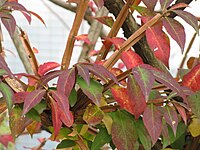Alate (Latin ālātus, from āla (“wing”)) is an adjective and noun used in entomology and botany to refer to something that has wings or winglike structures.
In entomology

In entomology, "alate" usually refers to the winged form of a social insect, especially ants or termites, though it can also be applied to aphids and some thrips.
Alate females are referred to as gynes, and are typically those destined to become queens. A "dealate" is an adult insect that shed or lost its wings ("dealation").
In botany

In botany, "alate" refers to wing-like structures on some seeds that use wind dispersal. It is also used to describe flattened ridges which run longitudinally on stems.
References
- Collins Dictionary (Seventh ed.). Collins. 2008. p. 34. ISBN 9780007261123.
- Hölldobler, Bert; Wilson, Edward O. (1990). The ants. Cambridge, Mass: Belknap Press of Harvard University Press. ISBN 978-0-674-04075-5.
- Mill, Alan E. (June 1983). "Observations on Brazilian termite alate swarms and some structures used in the dispersal of reproductives (Isoptera: Termitidae)". Journal of Natural History. 17 (3): 309–320. doi:10.1080/00222938300770231. ISSN 0022-2933.
- Hodgson, E. W.; Venette, R. C.; Abrahamson, M.; Ragsdale, D. W. (2005-12-01). "Alate Production of Soybean Aphid (Homoptera: Aphididae) in Minnesota". Environmental Entomology. 34 (6): 1456–1463. doi:10.1603/0046-225X-34.6.1456.
- Gilbert, James D. J.; Simpson, Stephen J. (October 2013). "Natural history and behaviour of Dunatothrips aneurae Mound (Thysanoptera: Phlaeothripidae), a phyllode-gluing thrips with facultative pleometrosis: Natural History of Dunatothrips Aneurae". Biological Journal of the Linnean Society. 109 (4): 802–816. doi:10.1111/bij.12100.
- Ho, Eddie K. H.; Frederickson, Megan E. (November 2014). "Alate susceptibility in ants". Ecology and Evolution. 4 (22): 4209–4219. Bibcode:2014EcoEv...4.4209H. doi:10.1002/ece3.1291. ISSN 2045-7758. PMC 4267860. PMID 25540683.
- Tian, Haisheng; Vinson, S. Bradleigh; Coates, Craig J. (2004-09-01). "Differential gene expression between alate and dealate queens in the red imported fire ant, Solenopsis invicta Buren (Hymenoptera: Formicidae)". Insect Biochemistry and Molecular Biology. 34 (9): 937–949. Bibcode:2004IBMB...34..937H. doi:10.1016/j.ibmb.2004.06.004. ISSN 0965-1748. PMID 15350613.
- Harrison, Lorraine (2012). Latin for Gardeners. Royal Horticultural Society. p. 20. ISBN 9781845337315.
External links
 The dictionary definition of alate at Wiktionary
The dictionary definition of alate at Wiktionary
This botany article is a stub. You can help Misplaced Pages by expanding it. |
This insect-related article is a stub. You can help Misplaced Pages by expanding it. |